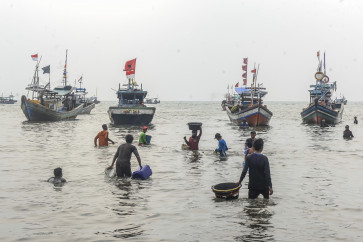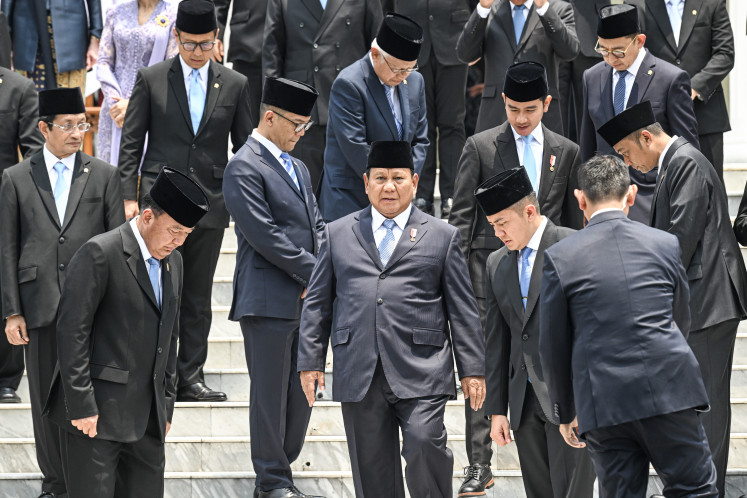Popular Reads
Top Results
Can't find what you're looking for?
View all search resultsPopular Reads
Top Results
Can't find what you're looking for?
View all search resultsWorking with the 'tri datu' in Kamasan
Elemental metal: Silversmith Wayan Sedana hammers a bowl out of copper sheet before carving and engraving the metal
Change text size
Gift Premium Articles
to Anyone
Elemental metal: Silversmith Wayan Sedana hammers a bowl out of copper sheet before carving and engraving the metal.
Kamasan is famous for the painting style that bears the village's name. Less well known are the beautiful and ornate works of the town's metalsmiths, who work in brass, copper and silver.
These metals are seen by Balinese Hindus as the tri datu, or three elements, that are required for rituals, says artisan Wayan Sedana.
With a hammer, anvil and tin snips, Wayan makes engraved silver bowls more than 40 centimeters across and that weigh up to a kilogram. He also makes delicate silver jugs for holy water and engraved copper pots for offerings.
'We use the ringgit measure for silver, 40 ringgit is 1000 grams, so a bowl like this takes 40 ringgit of silver,' Wayan says. 'It will sell for about Rp 2.5 million. Brass and copper are much cheaper, with a brass offerings bowl at around Rp 150,000.'
He holds a silver bowl. 'This size would take 21 days to make.'
Wayan said he started learning his craft at the age of nine. 'I began learning from my father when I was still in elementary school. I began my training with the carving. By the time I was 13, Dad would hammer the metals and I would carve. Later on I learned the art of the hammering. We started out with carving, as that is the most difficult aspect.'
He says that it took him a year to learn how to carve, but just four months to understand the technicalities of taking a piece of flattened copper or silver and how to hammer it into a thin bowl.
The metal is carved with reliefs pushed into the metal from the interior of the bowl, forming the raised pattern on the exterior, he says. 'These are carved twice. First from the inside, then again on the outside. So yes, it is a lot of work.'
Weapon to wonder: Nyoman Sudata etches a spent artillery shell, turning a piece of munitions into a beautiful art object.
Wayan says that the bowls, lidded jars and silver scoops for holy water are sent from this small village to Balinese Hindus as far away as Lombok and Java. It is only here in Kamasan that these sacred vessels are made.
As is often the case in Balinese studios that have been active for generations, Wayan's precious artworks are housed in glass cabinets in a tiny kiosk at the entrance to his workshop.
Behind the kiosk, Wayan's studio feels a bit like a fairy tale. Blackened water kettles sit on a wood stove and tumbling red bricks from a former building lie in piles.
In the center of the dimly lit room sits 62-year-old Nyoman Sudata, quietly etching on a brass artillery shell casing. He does not look up as he works.
These former weapons of war are turned into richly carved and etched brass tubes.
Wayan says he does not think too much about the fact these casings were once live ammunition.
Base metal to bowl: Starting with copper, brass or silver sheets, Wayan hammers the metal into bowls of jugs before decorating.
'They were not used in war, only for navy exercises. Then they send the cases down here. Sometimes the military orders special patterns with their insignias as souvenirs for retirement. Others are just for decoration. These are not to hold offerings in our Hindu ceremonies,' Wayan said.
These artisans feel no need to advertise ' and history is on their side.
For generations, families have come to Kamasan to buy sacred vessels that are then, like the craft itself, handed down over the years.
Nor is there a fear that their skills will be cast aside for fiber or wood copies.
'Hindu people buy these dishes for their ceremonies. A lot of people use wood or fiberglass that are much less expensive, but the wood and fiberglass offering vessels are not as holy. We need the silver, brass and copper metals in our religion,' says Wayan.
Without a son to take over his workshop, the long line of smiths in his family may be at an end. Again, Wayan is not concerned.
'I have a daughter, she is studying at university. She could learn the craft from me, but I don't feel she wants to. If I had a son, he would have followed me. But my brother has sons training under him, so this work will remain in our family,' says Wayan a member of just 12 families still producing the fine Kamasan silver, brass and copper work.
Transformation: Spent artillery shells are etched and carved to create superb craft.
' Photos by JB Djwan













